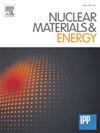The influence of variation in the ratio of components in two-phase lithium-containing ceramics on defect formation processes
IF 2.7
2区 物理与天体物理
Q1 NUCLEAR SCIENCE & TECHNOLOGY
引用次数: 0
Abstract
The aim of this study is to determine the effect of changing the ratio of components in the composition of two-component xLi2TiO3 − (1-x)Li2ZrO3 ceramics on structural distortions and degradation of strength and thermal parameters under high-dose neutron irradiation. The assessment of structural changes was carried out using the electron paramagnetic resonance (EPR) method, which is one of the most accurate methods that allows for a quantitative and qualitative assessment of structural changes caused by irradiation, as well as determining the concentrations of various types of defects depending on the irradiation fluence. It was found that in the case of two-component lithium-containing ceramics, the resistance to accumulation of radiolysis products is due to the effects of the presence of interphase boundaries that inhibit the formation of radiolysis products. According to the qualitative assessment of the EPR spectra, it was established that in the case of two-component ceramics, the formation of HC2 – centers occurs at higher irradiation fluences (above 5 × 1020 neutron/cm2), while for one-component ceramics, the formation of radiolysis products is observed at irradiation fluences above 1019 neutron/cm2. In this case, a comparative analysis of the concentrations of defects formed in the damaged layer and their evolution indicates an increase in resistance to defect formation processes due to a change in the ratio of components in the composition of two-component ceramics. The improved stability of two-component ceramics against disordering and defect accumulation is attributed to grain boundaries, which act as barriers to oxygen vacancy migration and defect clustering.
两相含锂陶瓷中组分比例的变化对缺陷形成过程的影响
本研究的目的是确定在高剂量中子辐照下,改变双组分xLi2TiO3−(1-x)Li2ZrO3陶瓷组成中组分的比例对结构畸变和强度及热参数退化的影响。结构变化的评估是使用电子顺磁共振(EPR)方法进行的,这是最准确的方法之一,可以定量和定性地评估辐照引起的结构变化,并根据辐照影响确定各种类型缺陷的浓度。研究发现,在双组分含锂陶瓷的情况下,对辐射分解产物积累的抵抗力是由于相间边界的存在抑制了辐射分解产物的形成。通过对EPR光谱的定性评价,确定了双组分陶瓷在较高的辐照强度下(5 × 1020中子/cm2以上)会形成HC2 -中心,而单组分陶瓷在1019中子/cm2以上的辐照强度下会形成辐射溶解产物。在这种情况下,对损伤层中形成的缺陷浓度及其演变的比较分析表明,由于双组分陶瓷组成中组分比例的变化,缺陷形成过程的阻力增加。双组分陶瓷在无序和缺陷积累方面的稳定性提高是由于晶界的存在,晶界作为氧空位迁移和缺陷聚集的屏障。
本文章由计算机程序翻译,如有差异,请以英文原文为准。
求助全文
约1分钟内获得全文
求助全文
来源期刊

Nuclear Materials and Energy
Materials Science-Materials Science (miscellaneous)
CiteScore
3.70
自引率
15.40%
发文量
175
审稿时长
20 weeks
期刊介绍:
The open-access journal Nuclear Materials and Energy is devoted to the growing field of research for material application in the production of nuclear energy. Nuclear Materials and Energy publishes original research articles of up to 6 pages in length.
 求助内容:
求助内容: 应助结果提醒方式:
应助结果提醒方式:


